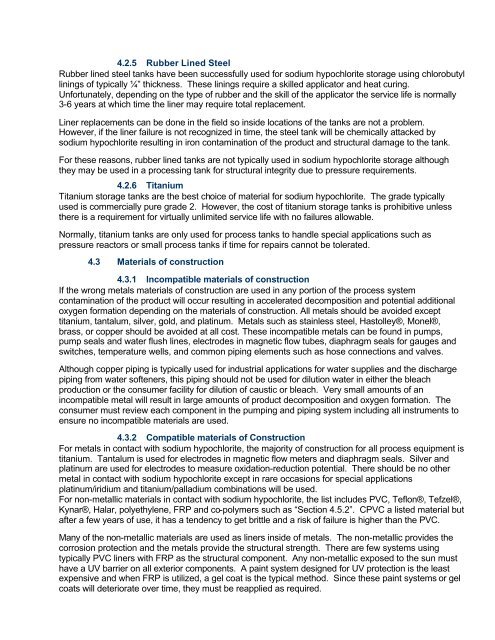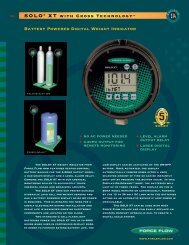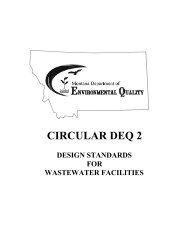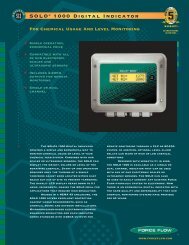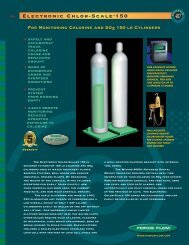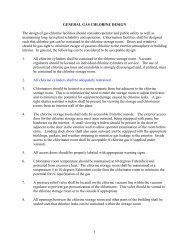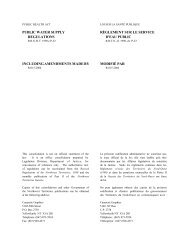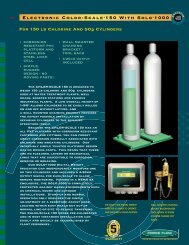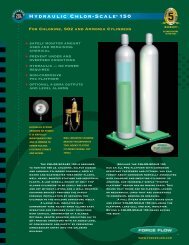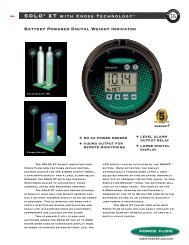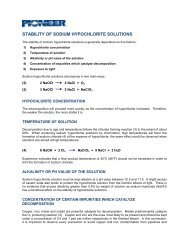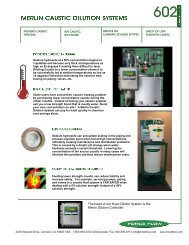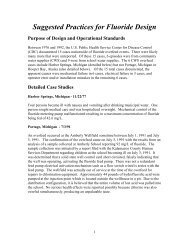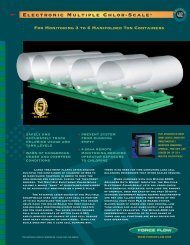Sodium Hypochlorite Handbook - Force Flow
Sodium Hypochlorite Handbook - Force Flow
Sodium Hypochlorite Handbook - Force Flow
You also want an ePaper? Increase the reach of your titles
YUMPU automatically turns print PDFs into web optimized ePapers that Google loves.
4.2.5 Rubber Lined SteelRubber lined steel tanks have been successfully used for sodium hypochlorite storage using chlorobutyllinings of typically ¼” thickness. These linings require a skilled applicator and heat curing.Unfortunately, depending on the type of rubber and the skill of the applicator the service life is normally3-6 years at which time the liner may require total replacement.Liner replacements can be done in the field so inside locations of the tanks are not a problem.However, if the liner failure is not recognized in time, the steel tank will be chemically attacked bysodium hypochlorite resulting in iron contamination of the product and structural damage to the tank.For these reasons, rubber lined tanks are not typically used in sodium hypochlorite storage althoughthey may be used in a processing tank for structural integrity due to pressure requirements.4.2.6 TitaniumTitanium storage tanks are the best choice of material for sodium hypochlorite. The grade typicallyused is commercially pure grade 2. However, the cost of titanium storage tanks is prohibitive unlessthere is a requirement for virtually unlimited service life with no failures allowable.Normally, titanium tanks are only used for process tanks to handle special applications such aspressure reactors or small process tanks if time for repairs cannot be tolerated.4.3 Materials of construction4.3.1 Incompatible materials of constructionIf the wrong metals materials of construction are used in any portion of the process systemcontamination of the product will occur resulting in accelerated decomposition and potential additionaloxygen formation depending on the materials of construction. All metals should be avoided excepttitanium, tantalum, silver, gold, and platinum. Metals such as stainless steel, Hastolley®, Monel®,brass, or copper should be avoided at all cost. These incompatible metals can be found in pumps,pump seals and water flush lines, electrodes in magnetic flow tubes, diaphragm seals for gauges andswitches, temperature wells, and common piping elements such as hose connections and valves.Although copper piping is typically used for industrial applications for water supplies and the dischargepiping from water softeners, this piping should not be used for dilution water in either the bleachproduction or the consumer facility for dilution of caustic or bleach. Very small amounts of anincompatible metal will result in large amounts of product decomposition and oxygen formation. Theconsumer must review each component in the pumping and piping system including all instruments toensure no incompatible materials are used.4.3.2 Compatible materials of ConstructionFor metals in contact with sodium hypochlorite, the majority of construction for all process equipment istitanium. Tantalum is used for electrodes in magnetic flow meters and diaphragm seals. Silver andplatinum are used for electrodes to measure oxidation-reduction potential. There should be no othermetal in contact with sodium hypochlorite except in rare occasions for special applicationsplatinum/iridium and titanium/palladium combinations will be used.For non-metallic materials in contact with sodium hypochlorite, the list includes PVC, Teflon®, Tefzel®,Kynar®, Halar, polyethylene, FRP and co-polymers such as “Section 4.5.2”. CPVC a listed material butafter a few years of use, it has a tendency to get brittle and a risk of failure is higher than the PVC.Many of the non-metallic materials are used as liners inside of metals. The non-metallic provides thecorrosion protection and the metals provide the structural strength. There are few systems usingtypically PVC liners with FRP as the structural component. Any non-metallic exposed to the sun musthave a UV barrier on all exterior components. A paint system designed for UV protection is the leastexpensive and when FRP is utilized, a gel coat is the typical method. Since these paint systems or gelcoats will deteriorate over time, they must be reapplied as required.


